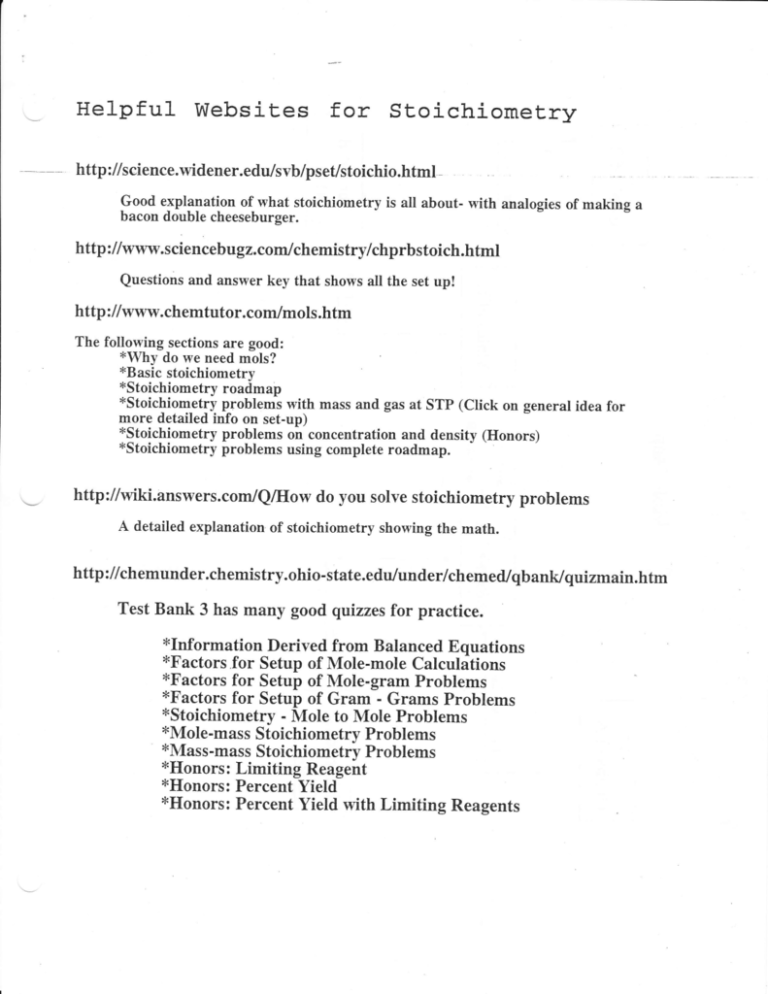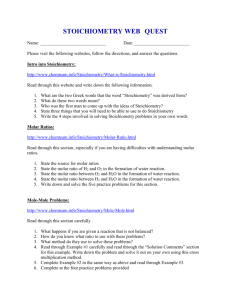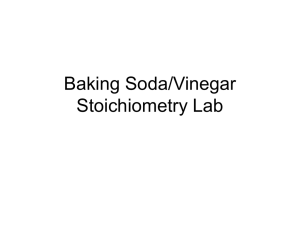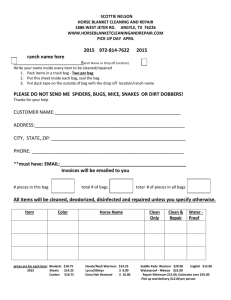Helpful Websit,es for Stoichiometry
advertisement

Helpful Websit,es for Stoichiometry
http ://science.widener.edu/svb/ps etlstoichio.html
Good explanation of what stoichiometry is all about- with analogies of making a
bacon double cheeseburger.
http ://www.sciencebugz.com/chemis trylchprbs toich.html
Questions and answer key that shows all the set up!
http ://www.chemtutor.com/mols.htm
The following sections are good:
*Why do we need mols?
*Basic stoichiometry
*Stoichiometry roadmap
*Stoichiometry problems with mass and gas at STP (Click on general idea for
more detailed info on set-up)
*Stoichiometry problems on concentration and density (Honors)
*Stoichiometry problems using complete roadmap.
http
:
/ I vriki.answers.
com/Q/Irow do you solve stoichiometry problems
A detailed explanation of stoichiometry showing the math.
http://chemunder.chemistry.ohio-state.edu/under/chemed/qbank/quizmain.htm
Test Bank 3 has many good qaizzes for practice.
*Information Derived from Balanced Equations
*Factors for Setup of Mole-mole Calculations
*Factors for Setup of Mole-gram Problems
xFactors for Setup of Gram - Grams Problems
*Stoichiometry - Mole to Mole Problems
*Mole-mass Stoichiometry Problems
*Mass-mass Stoichiometry Problems
*Honors: Limiting Reagent
*I{onors: Percent Yield
*Honors: Percent Yield with Limiting Reagents
i
H
q
a
E
()
F\
G
F
Fl
.il
Fq
F]
q{-r
-{
o
rh
o
'Q.{
cq.
E
o
o
|<i
G
N
N
tlpq
o
tr
'56)
-
H
gE
ti
a
q.{
q)
o
o
H
z
E{osv eam-
Section
Objectives
Relate volume calcul6:1,
tions in stoichiometry
,:i
to the inflation o{
autornobile safety
fue'axsed?
Use the concept
Stoichiorwetry and cars
ol
{
limiting reactants to
explain why changing
fuel-air ratios affects
engine performance,
;
far in your study of stoichiometry, you have
examined a number of chemical reactions with
Use percent yield to
practical applications-from banana flavoring
com p a re th e eff i ci e n cy.,l
to cosmetics to aspirin. But stoichiometrfs
of pollution-control
mechanisms
in cars.
practical importance goes beyond factories and
Iaboratories. When you drive a caE you are
depending on stoichiometry to keep you safe and make the car work
efEciently with the smallest possible impact on the environment.
So
Air-bag design depends on stoiGhiometric precision
Air.bags are designed to protect occupants in a car from injuries during
FEg[lre i5-] d
When used in combination with seat belts, air
bags can lessen the
severity of injuries in
the event of a foont-end
collision.
steeringwheel,windshie1d,orinstrumentpane1ashardastheywould
without the air bag. Stoichiometry and the principles of reactions studied-r
in Chapter 7 are used by air-bag designers to make certain that air bags
do not under-inflate or over-inflate. Bags that under-inflate do not providel
enough protection for the occupants, and bags that over-inflate can cause ri
injury or may even rupture, making them useless. To adequately
protect occupants, air bags must fully inflate within one-tenth of
a second after impact. The systems that make an air bag
work this quickly are shown in FEgasre E-"EB on the
next page. A front-end collision transfers
energy to a crash sensor that signals
Iar to a smali blasting cap. The ignitor
mixture called the gos generant, which
{,i;tt forms a gaseous product. The ignitor also
a
reaction occurs at a rate fast enough to fiIl the
bag before the occupant strikes it. This reaction
chamber releases the gas into the bag while a highefficiency filter keeps the reactants and the solid
products away from the gecupant.
2e4 Chanter 8
i
:
a high-speed front-end collision, as shown in Figarre E-tE. Mlhen inflated,,j
they gently slow down the occupants of a car so that they do not strike th+.:
!
+
i!
of sodium
For most current systems, the gas generant is a solid mixture
is almost
azide,(uNr, plus an oxidizer. The gas that inilates the bag
entjrelynitrogengas,N2,whichisproducedinthefollowingdecompositidnreaclion.
2NaNe(s)
_+
2Na(s) + BN2k)
and
However, this reaction alone cannot inflate the bag fast enough,
oxidizers
the sodium metal produced is a dangerously reactive substance'
they
that
so
such as ferric oxide, Fe2O3, are included in the gas generant
can immediately react with the sodium metal in a single-displacement
more than
reaction. This exothermic reaction also raises the temperature
a hundred degrees so that the gas frlls the bag faster'
6Na(s) + FezOs(s)
-+
3Na2O(5) + 2Fe(s)
subBut even sodium oxide is unsafe because it is an extre'mely basic
and moisture from
stance. Eventuall5r, it reacts with carbon dioxide, co2,
the air to form sodium hydrogen carbonate, or baking soda'
Na2O(s)
+ 2co2,€) + HzOGI)-----+
The volume of gas needed to
2NaHCOe(s)
fiIl an air bag of a certain volume
depends
ontheamountofgasavailableandthedensityofthegas'
Gas density, in turn, depends on temperature' To
calculate the amount of gas generaat necessary,
air-bag designers must know the stoichiom&= etry of the reactions and account for
energy changes in the reaction, which
may change the temPerature, and
thus the density, of the gas.
F:+i+:'i;:iln::1E
Figt*re 8-'tg
un-inflated bag
,&rash sensor
li{tne of several on auto)
Backup power suPPlY in
case of batterY failure
When a crash occurs, a
switch in the sensor
closes, and electricitY
from the battery or the
backup power suPPlY
flows to the inflator
behind the steering
wheel. The ignitor
within the inflator
heats up raPidlY, ignit'
ing the gas generant to
start the sodium azide
decomposition reaction. The nitrogen gas
that is made inflates
the air bag.
StoichiometrY 1295
Partner's Name:
Name:
Challenge for the Day: Design an Airbag... or BUST!!
The volume of gas released when an airbag inflates is critical. To9 mgch B-!s can over inflate the
bag, so it may burst. Too l-ittle gas will under inflate thebag, making it ineffective. It !s important
thit the correct amount of reactants be used to produce the exact volume of gas needed.
Stoichiometry can be used to predict the correct amount of reactants needed to fili the bag with gas.
The Challenge:
A ziplock bag is going to be your 'iaribag." The chemic+^ttgt y^oq qggoing to use to inflate the
b-ag ire baking sdaa (NaUCO3) and vinegar (acetic acid, HC2H3O2). The reaction is shown below.
(s) +
-NaHCO3
-H
CzHzOz(aq)*-N aC2H3O2(aq) +
(t) +
-HzO
(g)
-COz
Your challenge is to calculate how much baking soda and vinegar you will need to inflate your "ait
bag" with COz.
Things to Consider:
xMake sure the above equation is balanced'
xHow can you figure out the volume (in mL or L) of your bag?
*Is the vinegar pure acetic acid?
*Is the baking soda pure?
*What is the amouni of gas (in mL or L) of 1 mole of ANY gas under STP?
*How will you keep the iwo reactants separated until you are ready to start the reaction?
Before you start experimenting, discuss within your group how to approactr theproblem
Discuss-different asplects to consider. Calculate the amountbf reactants you hypothesize you will
need to taking into iccount the above considerations. Be sure to show your work with units.
Check your hypotheSis with the teacher, then test your hypothesis.
xWe found the volume of the bag by:
*We figured out the mass of baking soda by:
xWe figured out the volume of vinegar by:
*We obtained the approval of the teacher to test our experiment:
Observations from the experiment: Your observations should be detailed. Explain exactly what
you did and what happened. If you need to repeat the experiment, explain why and repeat your
calculations below. Obtain a stamp from your teacher when done.
You will be handing in this sheet and making a $oup poster. Use the rubric below to help guide
ln
in the preparation of the
Section
Description
Points
lntroduction
Your group briefly describes (in your own words) in one
paragraph how an airo-ag works and how it relates to
3
stoichiometry.
Procedure
You write a brief procedure in paragraph form what your
group did including how you kept the two reactants separate.
3
Calculations
Easy to follow calculations for the mass of ttre baking powder
and the volume of the vinegar. All numbers have units.
3
Diagrams
Yorir diagrams describe your set up.
1
Results
You include
brief statement of your results.
1
Assessment
You write a brief statement about how successfi.rl you were.
What would you do differently next time?
1
Participation
You stayed on task and did your share of the group work.
1
a







